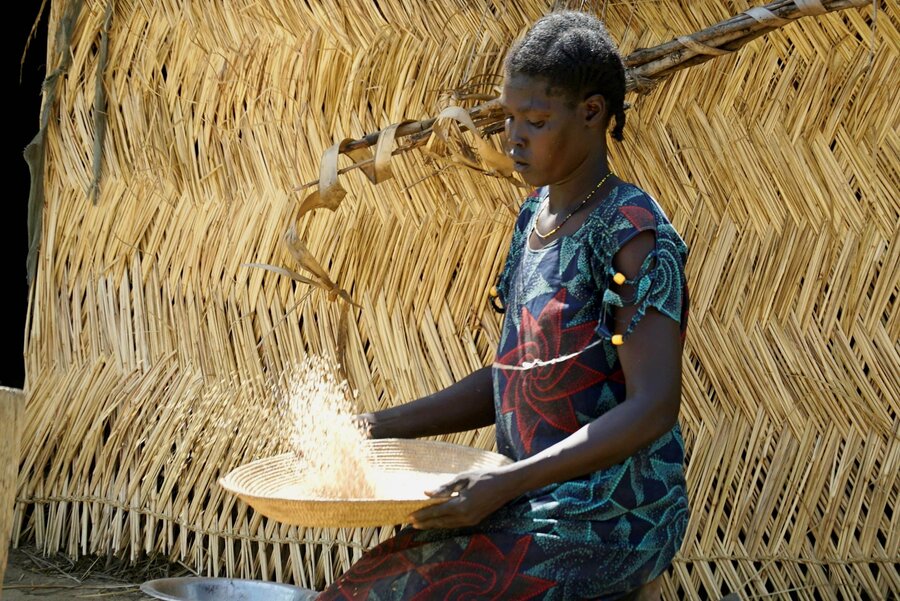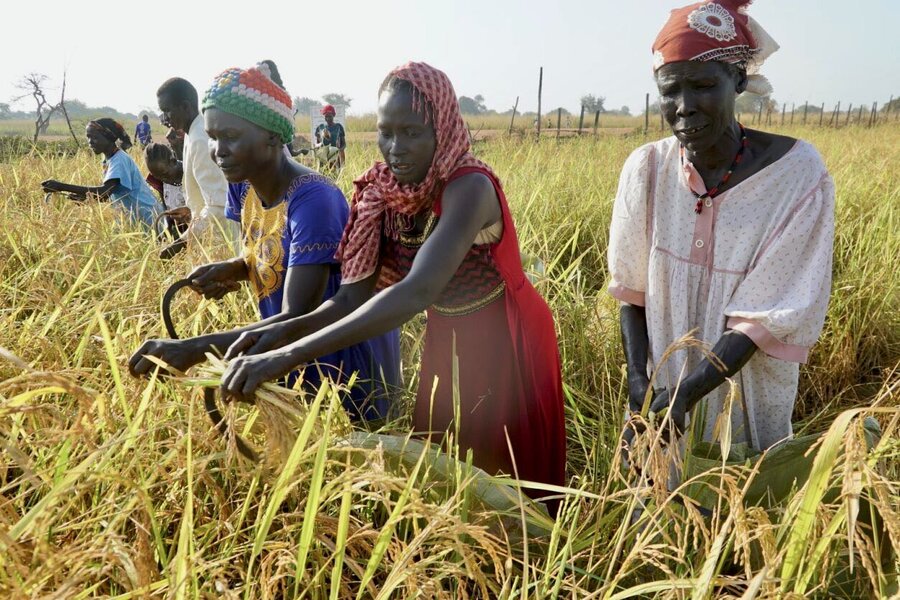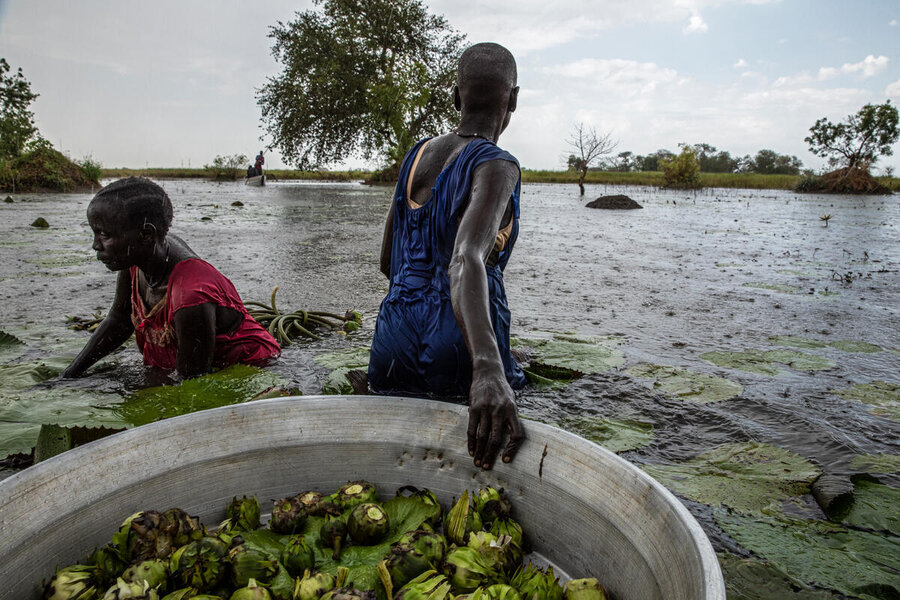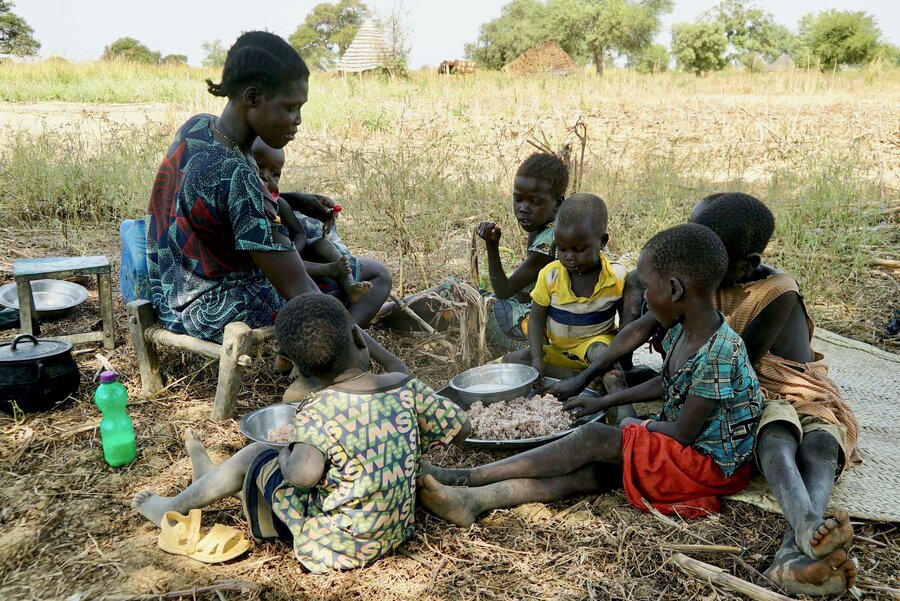Rice to the rescue: A WFP project changes lives and diets in flood-hit South Sudan

It is midday in Halbul, in northern South Sudan, and farmer Nyandeng Noon Agany is visibly exhausted as she walks home in the harsh dry season heat, after spending hours harvesting rice.
Noon’s six children are taking shelter from the searing sun under the porch of their home - a simple structure of wooden poles, a thatched roof and papyrus walls - eagerly awaiting their mother’s arrival.
“Life was really tough not so long ago,” reflects the 36-year-old mother as she removes a sack of unprocessed rice off her head. “I was surviving by cultivating peoples’ gardens and making what money or food I could.”
But the rice she begins to de-husk as she prepares lunch for her children has proved a windfall. Since joining a rice-growing scheme, supported by the World Food Programme (WFP), Noon and her children have been eating three meals daily with enough leftover rice to sell for income.
Rice is not part of traditional eating habits in Halbul, located in Northern Bahr El Gazal state, some 800 km north of the capital, Juba. Here and across much of South Sudan, sorghum has been the staple food.

But rice is fast growing in popularity, partly due to its versatility - but especially out of necessity. With the climate crisis unleashing extreme weather, particularly flooding in the region, cultivating sorghum and other customary crops is becoming near impossible, pushing families perilously close to hunger and despair.
“Our crops were affected by floods, and our land had become infertile,” Noon says.
On climate's frontlines
According to the United Nations Environment Programme, South Sudan is among the five most climate-vulnerable countries in the world, with decreasing rainfall in recent decades threatening the vast majority of families relying on agriculture and livestock to survive.
At the same time, flooding in swathes of the country, including Halbul village, has also decimated livelihoods and displaced hundreds of thousands of people. Both extreme weather patterns and historically low agricultural production due to longstanding conflict and underdevelopment underscore the importance of scaling up climate actions that build community resilience.
“We are witnessing climate extremes that are resulting in increased food insecurity, alongside conflict and significant economic shocks,” says Mary-Ellen McGroarty, WFP Representative and Country Director in South Sudan.
“Humanitarian needs are outpacing resources,” she adds, “and we really need sustained government investment in infrastructure and social services to help communities adapt and thrive in the face of more frequent climatic shocks and a new climate reality.”
Climate shocks can also push people to adopt harmful strategies to survive - such as producing charcoal and picking wild foods. Both can increase deforestation and environmental degradation, along with protection risks for women and children when they venture out to collect wood or food.

South Sudan’s climate crisis has deepened the country’s ongoing hunger crisis. The East African nation proportionally has the world’s highest number of hungry people, at 56 percent. Two-thirds of its population face extreme hunger, with some 43,000 experiencing catastrophic hunger levels.
Yet a funding shortfall means WFP can only provide half-rations to South Sudan’s hungriest people - and prioritize those facing the highest levels of food insecurity. This year’s funding outlook is especially grim. We need an additional US$921 million through June to keep life-saving assistance going and to invest in long-term resilience-building.
Building resilience - and peace
The payoffs of such investments can be seen in WFP’s rice-growing scheme on low-lying, flood-prone farmland, which Noon joined two years ago. It aims to support communities in improving food security, restoring livelihoods, strengthening resilience to shocks, and building self-reliance - while also contributing to peace.
Through the programme, communities are trained to plant, manage and harvest rice, a water-loving crop that thrives in flooded areas. Supported by the United Kingdom, the project and similar ones have reached some 1,200 families in Northern Bahr El Gazal and neighbouring Warrap states.

Around Halbul, Noon counts among 100 participants who have just harvested 45,000 kilograms of rice from a 25-hectare field - enough to sustain their families for the year.
Daniel Deng Yual, a 60-year-old father of six, is also celebrating the bumper harvest. He joined the project in 2020, at the height of devastating floods that swept across the country, uprooting and otherwise affecting nearly 900,000 people.
“Before enrolling on this project, I survived by collecting and selling firewood; I could barely afford to feed my family,” says Deng, filling some rice into a sack. “I can now afford three meals at home and meet my other needs.”
“We have effective and scalable solutions to help food insecure people to prepare for, respond to and recover from climate shocks and stresses,” says WFP's McGroarty. “With more funding, we plan to enhance the capacities of food-insecure communities and the Government of South Sudan, to allow them to prepare for, respond to, and recover from climate shocks and slow-onset climate change.”
